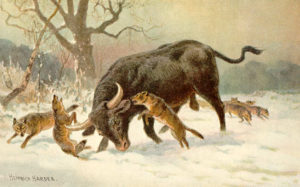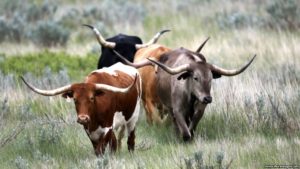 A recent research project in Europe aims to reintroduce the auroch–the wild ancestor of modern cattle–to European habitats. The auroch was an impressive animal, somewhat resembling today’s Spanish fighting bulls, that lived in the woodlands of Europe until 1627, when the last animal died in Poland. Extinct for centuries, a breeding program is working backwards to resurrect the auroch from domestic cattle–unlocking their wild genes, if you will. If you want, read more here.
A recent research project in Europe aims to reintroduce the auroch–the wild ancestor of modern cattle–to European habitats. The auroch was an impressive animal, somewhat resembling today’s Spanish fighting bulls, that lived in the woodlands of Europe until 1627, when the last animal died in Poland. Extinct for centuries, a breeding program is working backwards to resurrect the auroch from domestic cattle–unlocking their wild genes, if you will. If you want, read more here.
Now, that’s well and good for Europe. In Texas, we long ago worked to expand the few remaining bison, growing herds today that show no sign of slowing down their expansion. In fact, it takes active management to keep these “wild bison” from overrunning the plains of Texas. While not everyone wants bison on their land, there is an important lesson here: the value of bovine grazers to habitat management.
Much of Texas was originally a grassland–stretching far and wide from the coastal prairie to the High Plains of Llano Estacado, and beyond. The system was dominated in many ways by two wild components: fire and bison. Fires, whether sparked by lightning or set by native americans, would move the bison on to better grazing, and put nutrients back in the soil to fertilize next year’s growth. The impact of bison grazing was awesome: tillage of the soil from hoof action, and large-scale grazing of native grasses that invoked a response to regrow. Early free-range cattle grazing did much the same, as the famous longhorn cattle can attest. We mimic this effect today by applying prescribed grazing of cattle in a rotational structure that mimics intense grazing, followed by rest. The result is more abundant, nutritious grass, and a return of soil nutrients from fecal matter.

Herd of longhorns grazing in grassland
Combined with prescribed fire, these practices can help maintain grassland systems that are critical to wildlife that live there–quail, songbirds, antelope, and many others. For those seeking to manage for grassland habitats and the species that live there, the careful inclusion of bovine grazing is both a native and critical part of a functioning grassland habitat. Those landowners and managers whose primary land goal is wildlife management should welcome the effects of cattle or bison grazing, but do so with a solid, conservative grazing plan and reliable advice on stocking rates and rotation schedules. If you haven’t considered grazing cattle as part of your wildlife management plan, give it a second look–the benefits might surprise you!